This is part 11 in a series discussing forgotten RPGs (also see Part 1, Part 2, Part 3, Part 4, Part 5, Part 6, Part 7, Part 8, Part 9, and Part 10). That is, games most people have never heard of or that didn't last long on store shelves for one reason or another. This is another eclectic mix, but I included two for the Halloween season.


1. Night of the Ninja (by Tom Wall and Sandford Tuey; published by IIE Games Corporation in 1986)

Yes, you play a modern-day ninja. I'm not sure there's much more than that here. We are first met with character information. Every ninja gets Survival Points, which are essentially hit points, and they increase when a character goes up in level. Next we have Conscious Points, which is what it sounds like -- a measure to determine when a character loses consciousness due to things like to knockout gas and electric shocks. Then we are introduced to what is called Physical and Intellectual, which represent experience in certain areas. They are tracked separately, and both must meet certain thresholds in order for the character to increase in level. Abilities are rated on a scale from 10 to 50: Strength, Agility, Co-ordination, Stamina, Mental Discipline, Knowledge, and Pre-Science. There is also an Aggregate Score, which is the average of all abilities, and used when there is no clear abilitiy for a dice roll. A list of skills fall under Knowledge, and generally use that ability for dice rolls. Rounding out characters is done by determining values for Hearing/Listening and Vision. Even though we have already made dice rolls at this point, dice are finally discussed now. The two-page chaacter sheet has all the essentials and is a nice break from the busy sheets belonging to many of the past games in this blog series. Turn sequence and movement is fairly typical, with the nice addition of stamina rolls to maintain pace. Striking is level-based in that each side rolls 1d10, with the higher roll damaging the other, and the higher level gets the difference in levels as a bonus to both the roll and damage. As would be expected for ninjas, there are special rules for "move silent," dodging, climbing, falling, swimming, surprise, leaping attacks, strike to subdue, and structural damage. Weapons and special rules for them bring modifiers to rolls and damage, and may require a minimum level for use. The Ninja Master Section is about 3.25 pages, followed by a few pages about Ninjitsu. An adventure moduled, called Enrage the Night, is advertised in the back. I wonder if they ever released it. I'm not sure this is anything I would ever play. The rules seem servicable enough, but maybe incorporating some ideas into your favorite RPG would work better.


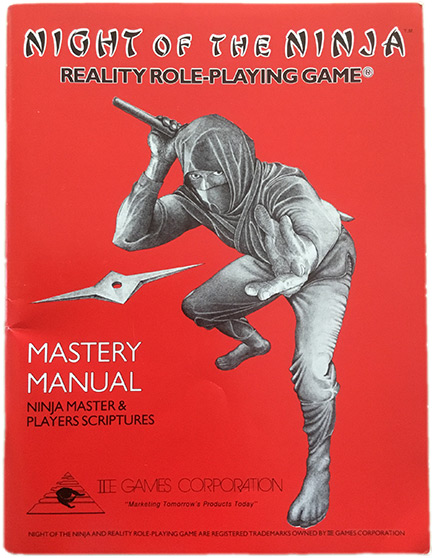


2. Time Drifters (by Zinny Brown and James K Shepard; published by Dimensional Strategies, inc. in 1990)

One would expect this game to be about time travel. The introduction states that time Drifters "combines the excitement of science fiction with the harsh realities of the past and incredible adventures of the future." Does it? The game uses both d10s and d6s. First stop is character creation. There are six abilities, rated by rolling 2d6+6: Might, Smarts, Quickness, Accuracy, Bravery, and Looks. Curiously, some get a bonus percentile if an 18 is rolled (not sure how this is applied yet). Certain modifiers apply for abilities and their ratings, such as damage, intiative, and accuracy. The basic mechanic is that a D% (called 2d10) roll is made, with that value referenced across the top of the Action Results Table (a small but nifty Time Master's Screen is included, and I don't think it's incorporated into the main book at all). That column is then compared to the row with the ability's rating to determine a color-coded result. It's similar to how Pacesetter's Action Table works. Anyway, after that is explained, we're back to character creation. Various types of characters (like Indians or Gunfighters) provide different modifiers and effects. They are essentially classes. We've got hit points and status levels, the latter being similar to D&D class levels. Equipment, common rules, talents (advantages), and a sample adventure round out this 78-page book. There's nothing really here involving science fiction or time travel. It's a Western, clearly planned to be the first genre in a series, but it seems like the only release. Is it any good? The system is relatively easy, feeling like a cross between old D&D and a Pacesetter game (Star Ace, Chill 1E, or Timemaster). I'm actually feeling the urge to play around with it a bit.


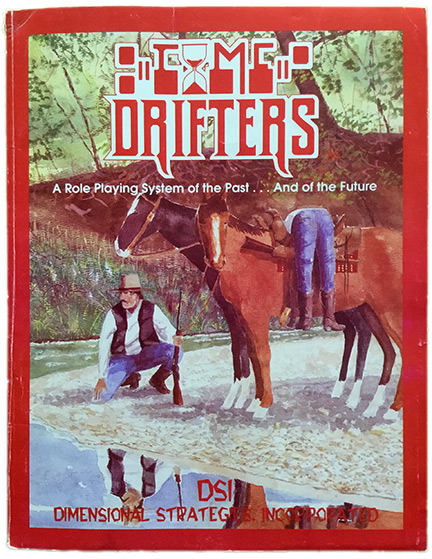


3. It Came from the Late, Late, Late Show (by Bradley K. McDevitt; published by Stellar Games in 1989)

There are a few versions of this in circulation. The one I am discussing has the cover shown. This game is different from most in that the players portray actors in a movie, typically about surviving aliens, zombies, and monsters. The introduction provides a lot of useful information, such about needing ten-sided dice, most rolls being D% roll under ability, and how to act appropriately stupid. Characters have 5 basic abilities, rated by rolling 4d10 for each: Build, Dexterity, Brains, Looks, and Fame. Survival Points are like Hit Points, equal to Build plus Fame. The final step is to make 20 1d10 rolls to place points into 20 Talents, such as unarmed combat or singing. Conflicts occur during Frames (a 10-second turn), Takes (6 Frames and a time for refresh), and Reels (60 Takes and also a time for refresh). Common rules are included, such as for various forms of movement, surprise, and fear. Interestingly, someone with 0 Survival Points must act like he is unconscious and dying until restored or at the negative equivalent of his starting value, at which time he is written out of the movie. There are other such rules akin to movie terminology, such as commercial breaks and walking off the set. Props are essentially special gear, as is wardobe. Page 26 begins the Director's Section. Lots of good information for maintaining the theme of being in a movie. Next up is about creating monsters, followed by a catalog of monsters and then extras that have no stats. That's it. Short but sweet. I think it works, but I feel that it is a very niche product. There were also a few supplements to expand the game.


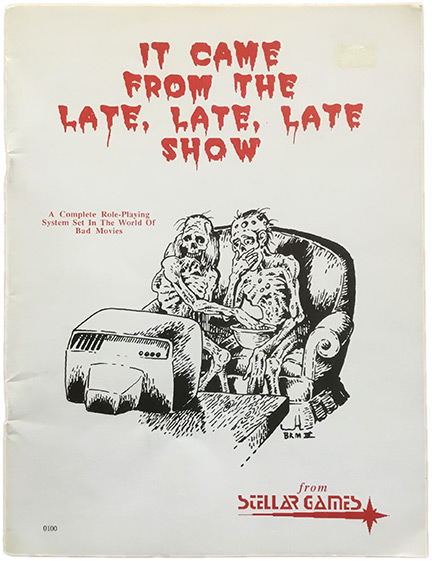


4. Don't Look Back: Terror is Never Far behind (by Chuck McGrew; published by Mind Ventures in 1994)

First Impression. Boring layout of the time. I'm not saying it's a bad thing, but it lacks atmosphere and kind of dampers my excitement of digging into it. We'll skip to page 17 for characters, but note that six-sided dice are used. Characters have 6 basic abilities, rated from -5 to +5: Fitness, Dexterity, Intelligence, Perception, Will, and Social. Acquired abilities are also a thing, but these seem to essentially be skills. There are also advantages and disadvantages. My thought here is that it is a modern system, vastly different from all those D&D holdovers. Adding to acquired abilities, they work as one would think, as bonuses to their relevant basic abilities. There are various types of characters, used as guides, including Gung Ho Military Types, Secret Agents, Techno-Nerds, Investigators, Scholars, Slackers, Big Dumb Jocks, Colleg Students, and Clergy. Action resolution involves adding up the ability rating and various modifiers, such as difficulties. This absolute value is the number of dice to roll. If it's a negative number, keep the three lowest dice; if it's a positive value, keep the three highest dice. Then compare the total to a chart to determine the level of success. The total must be 11 or higher for success (it is a constant baseline for succeeding). A quality is also attached to success, acting as a ± modifier to certain actions, such as damage. Page 71 begins Book 2, which is for creating adventures and contains information on the setting and paranormal. Two sample adventures follow, along with an appendix of useful chart and tables. A newer version seems to be available from Retro Roleplayer.


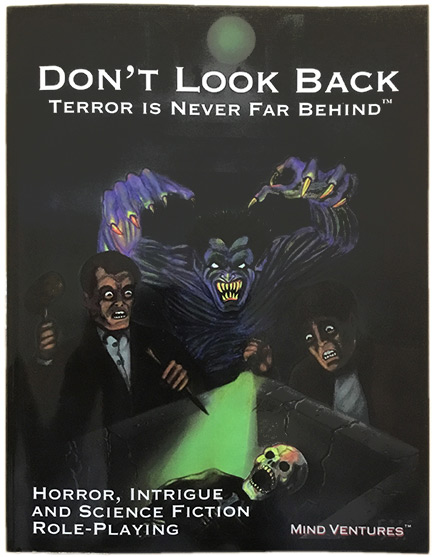


5. The Arcanum (by Stephan Michael Sechi and Vernie Taylor; published by Bard Games in 1985)

This is the second edition of what was part of The Atlantean Trilogy, and originated from material in The Compleat Adventurer, The Compleat Spell Caster, and The Compleat Alchemist -- all products designed to expand D&D. This is a densely-packed book with small type, but it is easy to read and fairly well-organized. I am going to skip over most of this, because it is essentially an offshoot of D&D. And I think it's fair to say that this is the precursor to Talislanta. Several races and LOTS of classes are provided, with what you would expect from a D&D race/class. There are 8 attributes that range from 5 to about 25, but capped by a racial maximum (typically fom 14 to 19): Intelligence, Will, Perception, Charisma, Strength, Dexterity, Constitution, and Speed. There are also skills, with effects ranging from modifiers to D% rolls. Unlike D&D, armor reduces damage (something that Swords & Six-Siders does too). There's a variety of magic styles, potions, items, spirits, etc. from pages 62 to 148. In fact, there are only two chapters, Character Creation and Magic. The appendix provides tables of weapons, supplies, and herbs, plus miscellaneous rules and sheets. There is a lot of content here and a good portion can probably be ported over pretty easily to D&D and OSR materials. A 30th Anniversary Edition is available from ZiLa Games.


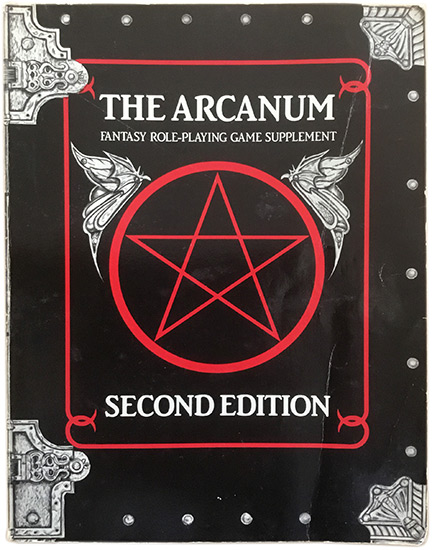


6. Holocaustic Dungeons (by Kristoffer A. Silver; published by Silver Wolf Games in 1986)

This is a rather unusual game. It is essentially a rules-lite, quick dungeon crawler. There are 5 basic attributes: Strength, Dexterity, Constitution, Fighting Ability, and Intelligence. I don't see any minimum or maximum values listed, so I assume that there are none. Then there are Hit Points and Nourishment, the latter used to track food and water. Weapon Ability is determined with a D% roll for each weapon the character knows how to use, which is determined by his Fighting Ability rating. Shield Ability counts as a weapon when it comes to Weapon Ability. Experience and Construction points are gained and used during play to increase Weapon/Shield Ability or basic attributes, respectively. Page 8 begins a list of weapons and armor. The bulk of action starts on page 13, as it explains the hex system in which dungeons are described and then the battle sequence. This works well as a solo game, since opponents act in a certain way. For example, they always use the most-powerful long-range weapons. If they don't have one, then they use the most-powerful medium range weapon. If he has a weapon that does more damage at the current range, regardless of maximum range, that gets used. You get the idea. Close combat rolls are actually similar to a project I am working on (Labyrinthine Adventures™, a new edition of Wee Warrior's Labyrinthine™). The percentile target is 50 + attacker's ability - defender's ability. Ranged combat is a bit trickier, being the attacker's ability with the weapon decreased by the amount of the defender's Dexterity over 10 or increased by it under 10. The real interesting part is the descriptions of rooms. Different types of rooms you can enter produce different effects, such as increasing attributes or adding a new friendly character. There are tables for adding random characters, signs present in rooms, weapons, treasures, and dangers. All in all, this is a neat little game, though it's primarily for exploring dungeons and fighting. The basic rules are complemented with several dungeon level books. While there are no maps per se, dungeons consist of a list of numbered rooms for use on a hexmap.

UPDATE: Holocaustic Dungeons is now part of the Precis Intermedia family of games.

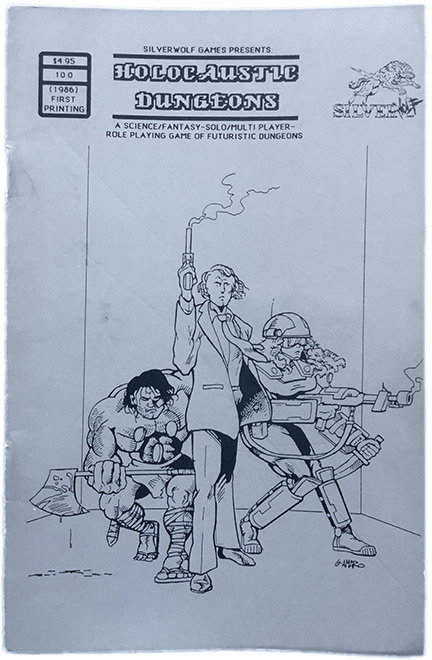


Number 11? That's quite a few Forgotten Games so far. Some on this batch should be just as forgotten as the others. Talking about old stuff, be sure to check out the new printing of Rune Stryders, the Fantasy-Mecha RPG and also The Misty Isles for Swords & Six-Siders (the original 1977 Wee Warriors Dungeon Kit updated for 1d6-based OSR gaming).


Part 12... |







